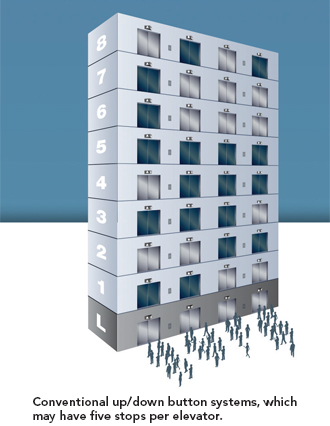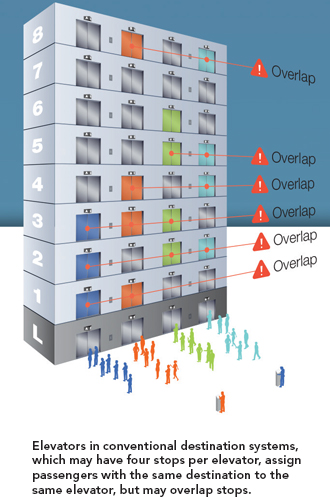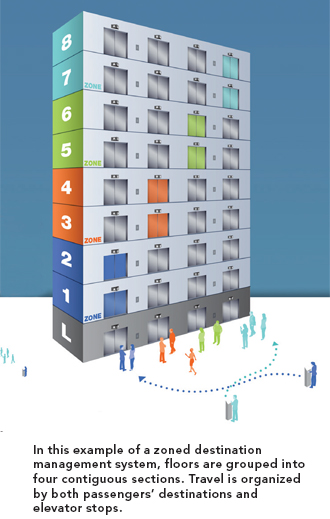Destination Dispatch Elevator Systems Benefit Passengers, Building Owners, and Design Professionals
Destination Dispatch (DD) Explained
Destination dispatch (DD) or destination management is the most significant advancement for mid- and high-rise elevators since automated operation. DD can minimize the number of stops which in turn could significantly reduce car crowding as well as reducing wait time, time to destination, and the number of intermediate stops while increasing handling capacity. Such impact is subject to building population and number of elevators in the building. Elevator passengers are loaded according to their destination rather than by their random arrival in the lobby. Instead of using standard, two-button hall call systems, passengers input the specific floor they want—before they enter the elevator.
For a typical elevator DD system, passengers enter their destination using mechanical keypads, touch pads, or touch screens provided at each floor. The input devices display each digit of the floor number entered by the passenger. These fixtures are either wall or pedestal mounted as selected by the design professional.
Once a destination floor is entered in a fixture, the system acknowledges the destination floor by displaying the requested floor number in the display immediately above the keypad or touchscreen. When the destination floor is entered, the assigned elevator for the passenger is flashed on the display together with command indicating the direction to the assigned elevator relative to the keypad or touchscreen device. The passenger can then walk to the correct elevator.
When the assigned car arrives the doors are fully opened and the floor assignments are displayed on the destination indicator (annunciator) inside the car.
The latest systems constantly monitor passenger demand to implement the most effective dispatching algorithm at any given moment. They constantly assess real-time passenger origin and destination data in order to assign cars. The dispatching algorithm continuously monitors the levels of elevator traffic during peak and non-peak hours as well as traffic in between floors throughout the day.
Some DD systems account for the walking distance for the elevator passenger from the input device to the assigned car. This calculation is used in dispatching decisions and also to assure the car does not depart before the passenger has entered the car. The walk rate calculation may be customized to account for geographical preferences. The system provides for an extended walk rate calculation for passengers with disabilities (if the handicapped button is pressed) or a specially designated elevator.
Zoned Destination Dispatching
Elevator manufacturers have enhanced DD systems by improving efficiencies and economies of traffic flow and travel time. Zoned destination dispatching (zoned DD), where elevators are assigned to zones or groupings of floors is one such development. By grouping passengers according to their destination and location of stops requested, zoned DD delivers improved management of peak morning up-traffic and two-way peak lunchtime traffic in addition to other features. For example, a conventional DD might assign passengers going to floors five and nine in the same car and passengers going to floors three and eight in the same car, so that instead of two cars stopping at four floors, each car will only stop at two floors. But with zoned DD where floors are grouped in segments, passengers are assigned according to their destination and their floor segment. Passengers going to floors three and five would be assigned to the same car, while passengers going to eight and nine would be assigned to another car.
“An evaluation of elevator motion dynamics reveals that when an elevator stops for contiguous floors or nearly contiguous floors, it spends less time in acceleration and deceleration states than if it were making the same number of stops separated by a large number of floors,” says Theresa Muenkel Christy, Engineering Fellow, Otis Elevator Company. “Therefore, elevators spend less time cycling between the lobby and floors above. This reduces round-trip time, allows more round trips, and, ultimately, increases the all-important elevator handling capacity.”
Passengers going to two different segments can be kept separate. This capability could serve two competing companies located in the same building that do not want employees riding together in case sensitive information is discussed.
Zoned DD compared with other elevator systems
Zoned DD systems have a number of advantages over earlier systems.



Images courtesy of Otis Elevator Company









